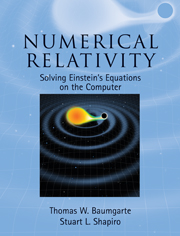Book contents
- Frontmatter
- Contents
- Preface
- Suggestions for using this book
- 1 General relativity preliminaries
- 2 The 3 + 1 decompostion of Einstein's equations
- 3 Constructing initial data
- 4 Choosing coordinates: the lapse and shift
- 5 Matter sources
- 6 Numerical methods
- 7 Locating black hole horizons
- 8 Spherically symmetric spacetimes
- 9 Gravitational waves
- 10 Collapse of collisionless clusters in axisymmetry
- 11 Recasting the evolution equations
- 12 Binary black hole initial data
- 13 Binary black hole evolution
- 14 Rotating stars
- 15 Binary neutron star initial data
- 16 Binary neutron star evolution
- 17 Binary black hole–neutron stars: initial data and evolution
- 18 Epilogue
- A Lie derivatives, Killing vectors, and tensor densities
- B Solving the vector Laplacian
- C The surface element on the apparent horizon
- D Scalar, vector and tensor spherical harmonics
- E Post-Newtonian results
- F Collisionless matter evolution in axisymmetry: basic equations
- G Rotating equilibria: gravitational field equations
- H Moving puncture representions of Schwarzschild: analytical results
- I Binary black hole puncture simulations as test problems
- References
- Index
17 - Binary black hole–neutron stars: initial data and evolution
Published online by Cambridge University Press: 05 March 2013
- Frontmatter
- Contents
- Preface
- Suggestions for using this book
- 1 General relativity preliminaries
- 2 The 3 + 1 decompostion of Einstein's equations
- 3 Constructing initial data
- 4 Choosing coordinates: the lapse and shift
- 5 Matter sources
- 6 Numerical methods
- 7 Locating black hole horizons
- 8 Spherically symmetric spacetimes
- 9 Gravitational waves
- 10 Collapse of collisionless clusters in axisymmetry
- 11 Recasting the evolution equations
- 12 Binary black hole initial data
- 13 Binary black hole evolution
- 14 Rotating stars
- 15 Binary neutron star initial data
- 16 Binary neutron star evolution
- 17 Binary black hole–neutron stars: initial data and evolution
- 18 Epilogue
- A Lie derivatives, Killing vectors, and tensor densities
- B Solving the vector Laplacian
- C The surface element on the apparent horizon
- D Scalar, vector and tensor spherical harmonics
- E Post-Newtonian results
- F Collisionless matter evolution in axisymmetry: basic equations
- G Rotating equilibria: gravitational field equations
- H Moving puncture representions of Schwarzschild: analytical results
- I Binary black hole puncture simulations as test problems
- References
- Index
Summary
Binary black hole–neutron stars have received significantly less attention than binary black holes or binary neutron stars. No black hole–neutron star binary has been identified to date. However, stellar population synthesis models suggest that such systems represent a significant fraction of all compact binary mergers ultimately visible in gravitational waves by the LIGO detector. In addition, the study of black hole–neutron star mergers is important in light of the localizations of short-hard gamma-ray bursts. These GRB sources are found in galactic regions of low star-formation devoid of supernovae associations, ruling out massive stars as progenitors: massive stars have very short lifetimes and would need to be replenished more rapidly than is possible in low star-formation regions to account for these bursts. A more plausible progenitor for a short-hard GRB is a compact binary containing a neutron star, i.e., either a binary neutron star or binary black holeneutron star. The short-hard burst time scales and energetics are consistent with GRB models based on the coalescence of such compact binaries, and the evolution time scale of over 1 Gyr between formation and merger is consistent with the low star-formation rate.
Black hole-neutron star binaries can merge in two distinct ways. The neutron star may either be tidally disrupted by the black hole companion before being consumed, or it may be swallowed by the black hole more or less intact.
- Type
- Chapter
- Information
- Numerical RelativitySolving Einstein's Equations on the Computer, pp. 562 - 595Publisher: Cambridge University PressPrint publication year: 2010



